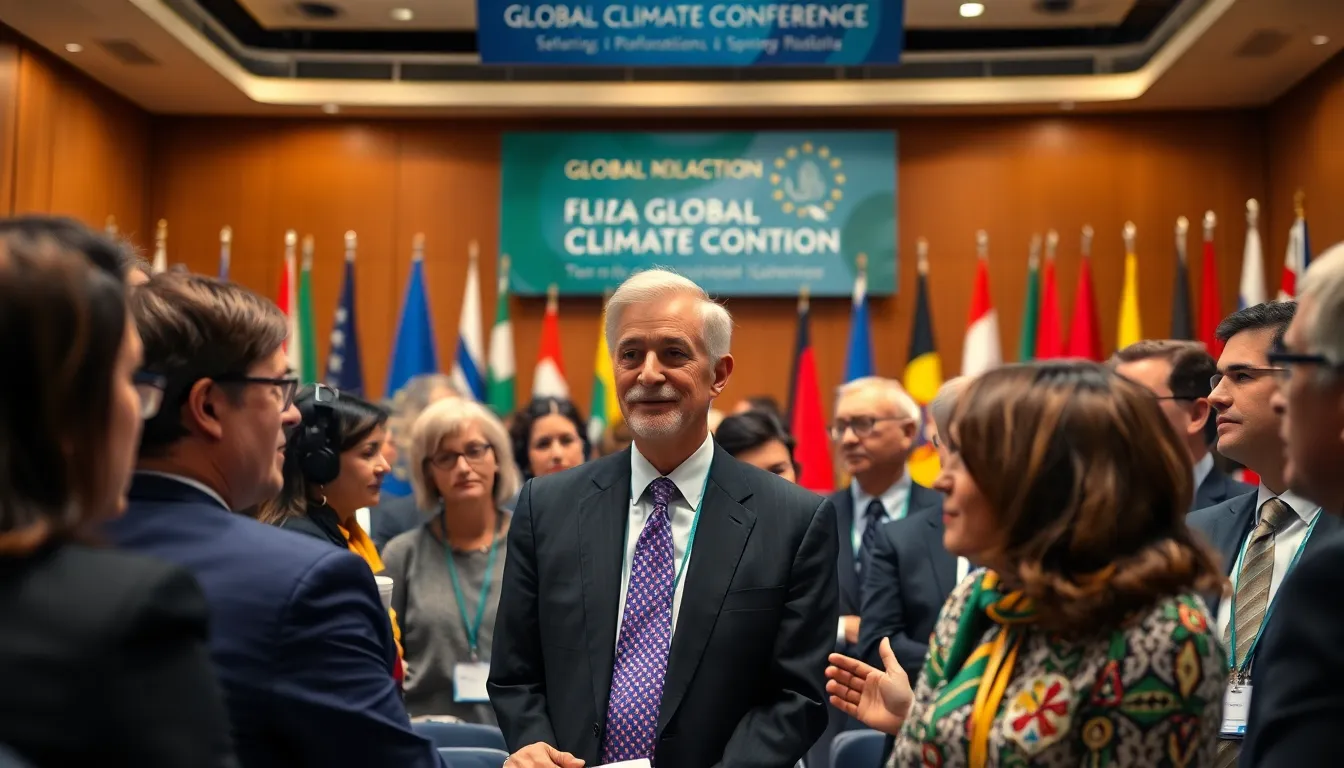The planet’s throwing a tantrum, and it’s time for everyone to step up and play nice. With rising temperatures, unpredictable weather, and the occasional polar bear trying to find a new home, world climate action has never been more critical. It’s not just about saving the cute animals—though let’s be honest, who doesn’t love a cuddly penguin? It’s about securing a livable future for generations to come.
As nations scramble to find solutions, individuals can’t sit idly by. Every small action counts, whether it’s reducing plastic use or swapping that gas-guzzler for a sleek electric ride. Join the movement, and let’s turn the tide on climate change together. After all, if we can’t save the planet, where are we going to put all our stuff?
Table of Contents
ToggleOverview of World Climate Action
World climate action encompasses global efforts to combat climate change through policies, initiatives, and grassroots movements. Countries are implementing various strategies to reduce greenhouse gas emissions, focusing on renewable energy and carbon neutrality. For instance, nations like Sweden and Denmark lead the way with ambitious goals to become carbon neutral by 2045.
International agreements such as the Paris Agreement play a crucial role in uniting countries. They commit to limiting global warming to well below 2°C above pre-industrial levels while pursuing efforts to limit the temperature increase to 1.5°C. Many nations have pledged to revise their targets periodically, reinforcing their commitments to sustainable practices.
Local initiatives contribute significantly to climate action. Cities across the globe are adopting smart city designs, promoting energy efficiency through public transportation and green building practices. Initiatives like tree planting campaigns engage communities in environmental stewardship, enhancing urban green spaces.
Moreover, businesses are increasingly recognizing the importance of sustainability. Corporations are setting environmental, social, and governance (ESG) goals, shifting towards sustainable operations to attract eco-conscious consumers. Many companies now report on their climate impact, showcasing transparency and accountability.
Grassroots movements also fuel climate action, encouraging individuals to make a difference. Activist groups organize events, raise awareness about climate issues, and drive public discourse. Campaigns like Fridays for Future mobilize youth to advocate for climate justice, amplifying voices of the younger generation.
Overall, diverse strategies and collective efforts underscore the urgency and necessity of world climate action. These initiatives foster collaboration among governments, businesses, and communities, aiming for a sustainable future for all.
Global Climate Agreements

Global climate agreements serve as essential frameworks that foster international cooperation in the fight against climate change. They unite countries around common goals, guiding individual and collective actions.
Paris Agreement
The Paris Agreement, established in 2015, aims to limit global warming to well below 2 degrees Celsius above pre-industrial levels. Representatives from 196 countries adopted this landmark deal, emphasizing the importance of reducing greenhouse gas emissions. Countries set national climate action plans, known as Nationally Determined Contributions (NDCs), which outline individual targets. Nations must revisit and enhance their NDCs every five years, increasing ambition over time. Funding for climate adaptation and mitigation initiatives also plays a critical role in supporting developing nations. The agreement reflects crucial cooperation, reinforcing the commitment to combat climate change.
Kyoto Protocol
The Kyoto Protocol, adopted in 1997 and implemented in 2005, represents the first international treaty with legally binding emissions reduction targets. Its primary goal focused on industrialized countries, requiring them to cut greenhouse gas emissions by an average of 5.2% below 1990 levels during the 2008-2012 commitment period. Emissions trading, a mechanism introduced in this protocol, allowed countries to buy or sell emissions allowances, aiming for cost-effective solutions. Although it successfully positioned climate change on the global agenda, challenges in compliance and participation arose, particularly with major emitters. Future climate negotiations often reference the Kyoto Protocol’s lessons learned, fostering better strategies for upcoming agreements.
Key Players in Climate Action
Climate action involves a network of diverse players actively working toward sustainable solutions. Governments and non-governmental organizations (NGOs) play significant roles.
Governments
Governments worldwide implement policies targeting climate change mitigation. Many countries, like Sweden and Denmark, aim for carbon neutrality by 2045. They establish frameworks for reducing greenhouse gas emissions, relying on international agreements such as the Paris Agreement. The Paris Agreement holds nations accountable for their commitments, requiring them to refine their Nationally Determined Contributions (NDCs) every five years. Local governments also contribute by promoting initiatives like renewable energy projects and urban green spaces.
Non-Governmental Organizations
Non-governmental organizations (NGOs) drive advocacy efforts for climate justice and sustainability. Organizations like Greenpeace and the World Wildlife Fund mobilize community support and raise awareness about pressing environmental issues. They often collaborate with grassroots movements, amplifying voices calling for immediate action on climate change. NGOs work on legal challenges, pushing for stricter regulations and policies in various jurisdictions. By conducting research and providing education, these entities empower communities to advocate for more sustainable practices and hold corporations accountable for their environmental impact.
Challenges to Effective Climate Action
Addressing climate change encounters various challenges that hinder progress. Political factors often obstruct coordinated efforts and reduce priorities for climate action.
Political Obstacles
Political obstacles significantly impact climate initiatives. Government instability can derail long-term planning, causing delays in important policies aimed at reducing emissions. Additionally, conflicting interests among countries often impede collaboration on global agreements. Legislative bodies may resist implementing necessary reforms due to lobbying from powerful industries that prioritize profit over sustainability. Budget constraints frequently limit funding for climate-related projects, suggesting that effective climate strategies remain vulnerable to the whims of political agendas. Recognizing these hurdles forms a critical part of understanding the broader landscape of climate action efforts.
Economic Considerations
Economic considerations play a pivotal role in climate action effectiveness. Transitioning to renewable energy requires substantial upfront investment, posing challenges for nations with limited financial resources. Financial markets can hesitate to support green technologies due to perceived risks or uncertainties in returns. Moreover, the fossil fuel industry’s economic influence can stymie progress, especially in regions reliant on traditional energy sources for jobs and revenue. Companies that prioritize short-term gains may resist investing in sustainable practices, presenting further hurdles. Addressing these economic factors is essential for establishing a robust framework for climate action, ensuring sustainable solutions become viable and accessible.
Innovations in Climate Solutions
Global climate action leans heavily on innovative solutions to address environmental challenges. These advancements play a pivotal role in reducing greenhouse gas emissions and securing a sustainable future.
Renewable Energy Technologies
Renewable energy technologies emerge as crucial tools in combating climate change. Solar power offers the ability to generate electricity without emissions. Wind energy harnesses air currents to produce clean power, while hydropower taps into flowing water. Geothermal systems utilize heat from the Earth, providing consistent energy. Recent advancements in energy storage technologies enhance the reliability of these sources. Countries like Germany and China lead in deploying large-scale renewable projects, significantly decreasing reliance on fossil fuels. Increased investment in research and development accelerates the shift towards sustainable energy solutions.
Carbon Capture and Storage
Carbon capture and storage (CCS) technologies play an essential role in reducing atmospheric carbon dioxide levels. CCS captures emissions from sources like power plants before they enter the atmosphere. After capture, these emissions undergo a compression process for transportation to storage sites. Under suitable geological formations, the carbon dioxide can remain securely stored for centuries. Recent implementations in the United States and Norway showcase CCS’s effectiveness in reducing overall emissions significantly. Investments in CCS research continue to yield improvements for commercial feasibility. Enhancing these technologies can lead to substantial climate benefits in global efforts against climate change.
The fight against climate change requires immediate and unified action from all sectors of society. With the challenges ahead, it’s crucial for individuals, businesses, and governments to work together and embrace innovative solutions. By adopting sustainable practices and supporting policies that promote renewable energy, everyone can contribute to a healthier planet.
Grassroots movements and global initiatives are paving the way for a more sustainable future. As awareness grows, the collective effort to combat climate change becomes stronger. It’s a shared responsibility to protect the Earth for future generations. Every action counts and together, they can make a significant impact.







